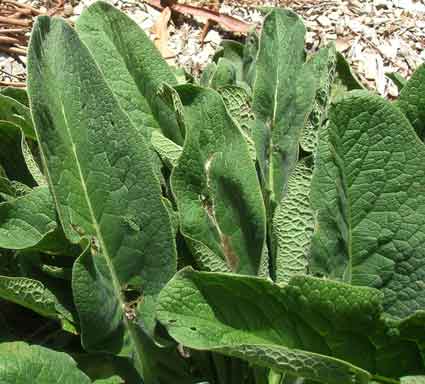
Comfrey / Symphytum officinale

Boraginaceae
Symphytum
officinale
Boneset, Bruisewort, Consormol, Knitback, Knitbone, Assear, Consolida, Consound, Gumplant, Healing herb, Miracle herb, Slippery root, Wallwort, Yallue.
Astringent, demulcent, emolient , expectorant, cell proliferant, haemostatic , refrigerant ,vulnerary.
Leaf and Root
Allantoin, mucilage, tannins, resin, steroidal saponins, essential oil, pyrrolizioline, alkaloids, inulin, gum, choline, consollidine, symphyto-cynoglossine, carotene, vitamins C and E, B12, protein (almost 35% protein), complete glycosides, sugars beta-sitosterol, zinc.
Comfrey has been used since the time of the ancient Greeks and Romans for healing wounds on the battle field. It is still used today for healing wounds, burns, bruising and skin complaints. The Allantoin stimulates cell proliferation both internally and externally. Externally an oil or cream made from Comfrey is good for sprains and arthritic joints. Used as a compress it is great for fractures, pulled ligaments or torn muscles. The Allantoin also helps promote the growth of cartilage, bone and connective tissue. As a poultice it is also good for varicose ulcers and, as a compress, for varicose veins. The root is also good for gastric and duodenal ulcers because of its mucilage content. Do not use Comfrey on really deep wounds as it can start the top tissue layer forming before the wound has healed deeper down. As an expectorant, the root helps soothe any inflammation whilst assisting expectoration. Now to the cancer controversy - the alkaloid pyrrolizidine is the culprit and can cause liver damage if taken in a huge hose. The disorder is known as HVOD (hepatic veno-occlusive disease). So far only two reported cases in the world. The following results were published in a Science mag by cancer authority Bruce Ames Ph.D., Chairman of the Bio-Chemistry Department at the University of California, Berkley. His findings were as follows: “One cup of Comfrey tea posed - the same cancer risk as one peanut butter sandwich, it contains traces of the carcinogen aflatoxin one third the risk of eating one raw mushroom - they contain traces of the carcinogen hydrazine half the risk of one diet soda which contains saccharin 1/100th the risk of a standard beer or glass of wine which contains the natural carcinogen ethyl alcohol” Also, Comfrey/Pepsin tablets (which incidentally were taken by the two people who developed HVOD) carry up to 200 times the risk of Comfrey tea. So make up your own minds on this issue . Other Uses : Biomass; Compost; Gum The plant grows very quickly, producing a lot of bulk. It is tolerant of being cut several times a year and can be used to provide 'instant compost' for crops such as potatoes. Simply layer the wilted leaves at the bottom of the potato trench or apply them as a mulch in no-dig gardens. A liquid feed can be obtained by soaking the leaves in a small amount of water for a week, excellent for potassium demanding crops such as tomatoes. The leaves are also a very valuable addition to the compost heap. A gum obtained from the roots was at one time used in the treatment of wool before it was spun.)
Carried when travelling to ensure safety and protect from injury. Also put into luggage or suitcase to ensure it is not stolen. The root is used in money spells to attract money.
https://www.theherbalist.com.au/herb_gallery/comfrey